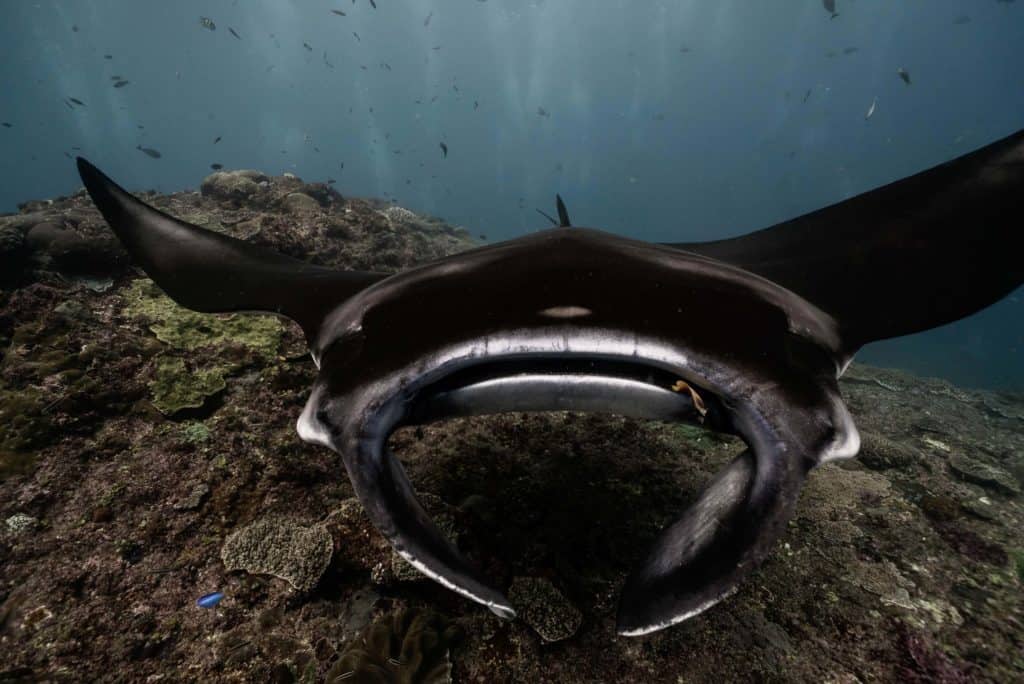Witnessing a manta ray in the wild can be a daunting experience, especially if you are in the water and one starts to approach you.
These animals are HUGE, often up to 7 meters across, and weigh as much as 1500kg. An unsuspecting swimmer could have a real feeling of panic if not acquainted with these rays.
In this post, we’re going to take a closer look at manta rays and more specifically provide an answer to can manta rays kill you?
No, manta rays can not kill you, and there is no need to panic around these animals. They do not have a barbed stinger, unlike their stingray cousins.
Can Manta Rays Really Kill People?
Manta rays are some of the most majestic animals in our oceans. They are filter feeders that feed on zooplankton, krill, and small fish.
Unlike stingrays, manta’s do not have a stinger. This means that they cannot kill people and have no way of harming humans.
Often because they do look similar to stingrays but are much larger, people can instinctively panic when they see manta’s in the wild.
There is really no need to worry about these rays, they are gentle giants that are similar to cows in the sense that they are calm, gentle grazers of the ocean.
Has A Manta Ray Ever Killed Anyone?
Manta rays have never killed anyone, and do not have the means to harm humans.
Like stingrays, manta’s do have a long whip-like tail, however, they do not have the barbed stinger that the stingray does.
Even stingray attacks are incredibly rare. There are only two reported stingray fatalities reported every year, which is incredibly low based on the stingray population,
Manta rays, stingrays, and other species of rays are non-aggressive animals and are not a threat to humans.
They would much rather flee than attack a human, which is why the attacks are so low. Most stingray attacks happen accidentally, as the rays bury themselves in the sand in shallow waters.
Unsuspecting swimmers may accidentally step on a ray, and therefore they may find themselves stung in the legs, ankles, or feet.
The good news is that stingray venom is not deadly to humans. The deaths that do occur from stingrays are usually down to the barb being stuck in a human’s chest or heart.
Stingrays get a bit of a bad reputation because of their barb, but they are really not out to harm anyone.
They are surprisingly friendly and curious animals, and providing you treat them with respect there should be no need to worry.
Are Manta Rays Dangerous?
Manta rays are NOT dangerous whatsoever to humans, they have no means of hurting a human and their only form of defense is fleeing.
They are filter feeders, and therefore do not have sharp teeth that could inflict damage to a human.
They also high a high tolerance for humans, which means swimming with mantas is something many humans enjoy in some areas of the world.
These curious animals will glide around swimmers in the ocean majestically, and will sometimes swim right up close to divers.
With that said, manta rays may defend themselves if they feel threatened, just like all wild animals.
How Do Manta Rays Defend Themselves?
Due to the manta rays’ enormous size, they have very few natural predators in the wild. In fact, it’s only large sharks and killer whales that will try to take on a manta ray.
These giant rays often rely on their size alone to deter predators from attacking them, but they can also move pretty swiftly through the water when they need to.
Most manta rays swim at an average speed of 14 km/h, but can swim at speeds of 35km/h in short bursts, allowing them to flee from predators when needed.
As these rays are made of cartilage, they are incredibly flexible and able to outmaneuver most of their predators in the ocean.
Combine their gymnast skills with speed, and even the swiftest of sharks struggle to keep up with a manta ray that doesn’t want to be lunch.
Final Thoughts
So, can manta rays kill you? No, they are not capable of killing humans even if they really wanted to.
Unlike their stingray cousins, mantas don’t have a venomous barb that they use to defend themselves from predators, instead, they use “flight” as a means to escape.
Their size alone keeps manta rays relatively safe in the ocean, and because of this, they have very few natural predators.
These giant rays really are gentle giants, they are often friendly towards humans and will swim up close to divers to get a closer look.
There is no need to be afraid of manta rays, they are not dangerous to humans at all, and if you do come across a manta ray in the wild, try to enjoy the once-in-a-lifetime experience.
Hopefully, this post has been helpful and you’ve learned why manta rays are completely harmless to humans in this post.
Thanks for taking the time to read this article and feel free to share it with others who may find it valuable.

Hi, I’m George – the founder of MarinePatch. I created this blog as marine wildlife has been my passion for many years. I’ve spent over a decade in the marine wildlife industry and spent years out in the field conducting research. In today’s modern world, an online blog is the best place for me to share my findings and reach as many people as possible to help educate and inspire others. Enjoy your time here and you’re welcome back anytime!

